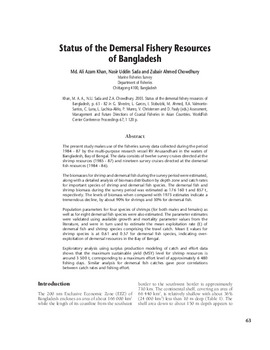Status of the demersal fishery resources of Bangladesh
Abstract
The present study makes use of the fisheries survey data collected during the period 1984 - 87 by the multi-purpose research vessel RV Anusandhani in the waters of Bangladesh, Bay of Bengal. The data consists of twelve survey cruises directed at the shrimp resources (1985 - 87) and nineteen survey cruises directed at the demersal fish resources (1984 - 86). The biomasses for shrimp and demersal fish during the survey period were estimated, along with a detailed analysis of biomass distribution by depth zone and catch rates for important species of shrimp and demersal fish species. The demersal fish and shrimp biomass during the survey period was estimated as 176 160 t and 857 t, respectively. The levels of biomass when compared with 1973 estimates indicate a tremendous decline, by about 90% for shrimps and 30% for demersal fish. Population parameters for four species of shrimps (for both males and females) as well as for eight demersal fish species were also estimated. The parameter estimates were validated using available growth and mortality parameter values from the literature, and were in turn used to estimate the mean exploitation rate (E) of demersal fish and shrimp species comprising the trawl catch. Mean E values for shrimp species is at 0.61 and 0.57 for demersal fish species, indicating over-exploitation of demersal resources in the Bay of Bengal. Exploratory analysis using surplus production modeling of catch and effort data shows that the maximum sustainable yield (MSY) level for shrimp resources is around 3 500 t, corresponding to a maximum effort level of approximately 6 480 fishing days. Similar analysis for demersal fish catches gave poor correlations between catch rates and fishing effort

